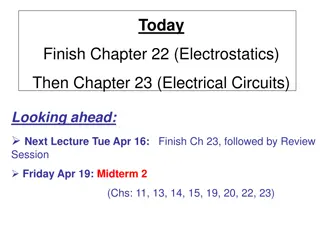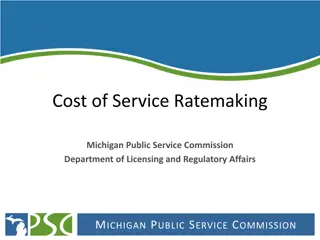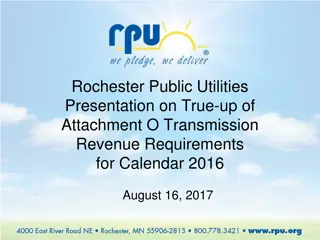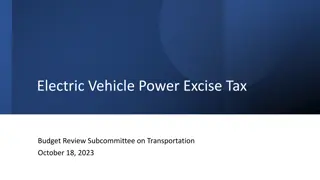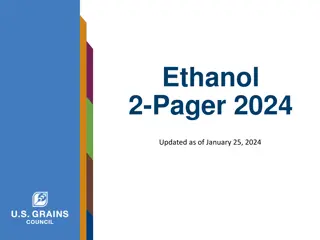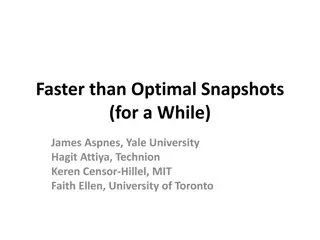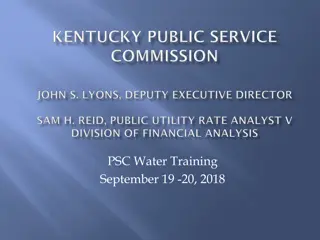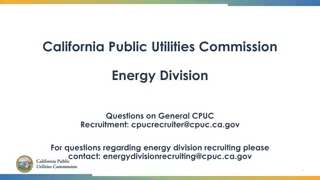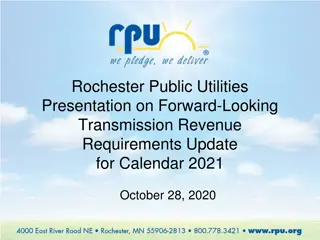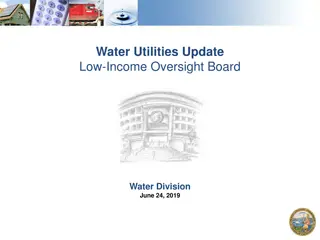Snapshot of EV-Specific Rate Designs Among US Electric Utilities
Present methods and objectives in designing EV-specific electric utility rates in the US. Explore the policy-driven objectives and framework used for categorizing EV-specific rates. Learn about the two broad concepts guiding retail rate design and the potential basis for EV-specific rate designs.
Download Presentation

Please find below an Image/Link to download the presentation.
The content on the website is provided AS IS for your information and personal use only. It may not be sold, licensed, or shared on other websites without obtaining consent from the author.If you encounter any issues during the download, it is possible that the publisher has removed the file from their server.
You are allowed to download the files provided on this website for personal or commercial use, subject to the condition that they are used lawfully. All files are the property of their respective owners.
The content on the website is provided AS IS for your information and personal use only. It may not be sold, licensed, or shared on other websites without obtaining consent from the author.
E N D
Presentation Transcript
A Snapshot of EV-Specific Rate Designs Among U.S. Investor-Owned Electric Utilities Peter Cappers, Andrew Satchwell (Berkeley Lab) Cameron Brooks, Sam Kozel (E9 Insight) May 11, 2023 This work was funded by the U.S. Department of Energy s Office of Electricity under Contract No. DE-AC02-05CH11231.
How are EV-Specific Electric Utility Rates Designed Presently? Methods Objective Develop a framework for identifying the design elements of EV-specific rates Provide regulators, utilities, and the EV industry with a more robust understanding of how EV-specific electric utility rates could be designed and how they are actually being designed presently in the United States Collect electric utility tariff filings with state utility regulators of EV-specific rates Apply the framework to the tariff filings to develop a database that categorizes EV-specific rates Caveat Evaluate the database to characterize the landscape of EV-specific rate designs Focused on IOUs, excluded energy marketers, municipal utilities, and cooperative utilities Did not assess customer enrollment or response to EV-specific rate designs 2
Retail Rates are Designed Based on Two (2) Broad Concepts Recover a utility s costs (i.e., revenue requirement), apply sound ratemaking principles; and are considered just and reasonable Satisfy certain policy and/or market objectives that can vary based on a state s distinct rules, regulations, and policies, as well as different stakeholder motivations 3
Five (5) Policy-Driven Objectives Potentially Used as the Basis for EV-Specific Rate Designs Promote EV adoption Recover a utility s costs (i.e., revenue requirement), apply sound ratemaking principles; and are considered just and reasonable Satisfy certain policy and/or market objectives that can vary based on a state s distinct rules, regulations, and policies, as well as different stakeholder motivations Grid management System economic efficiency Decarbonization Equity 4
Five (5) Policy-Driven Objectives Used as the Basis for EV-Specific Rate Designs Promote EV adoption Recover a utility s costs (i.e., revenue requirement), apply sound ratemaking principles; and are considered just and reasonable Satisfy certain policy and/or market objectives that can vary based on a state s distinct rules, regulations, and policies, as well as different stakeholder motivations Grid management System economic efficiency Decarbonization Equity 5
Five (5) Policy-Driven Objectives Used as the Basis for EV-Specific Rate Designs Promote EV adoption Recover a utility s costs (i.e., revenue requirement), apply sound ratemaking principles; and are considered just and reasonable Satisfy certain policy and/or market objectives that can vary based on a state s distinct rules, regulations, and policies, as well as different stakeholder motivations Grid management System economic efficiency Decarbonization Equity 6
Five (5) Policy-Driven Objectives Used as the Basis for EV-Specific Rate Designs Promote EV adoption Recover a utility s costs (i.e., revenue requirement), apply sound ratemaking principles; and are considered just and reasonable Satisfy certain policy and/or market objectives that can vary based on a state s distinct rules, regulations, and policies, as well as different stakeholder motivations Grid management System economic efficiency Decarbonization Equity 7
Five (5) Policy-Driven Objectives Used as the Basis for EV-Specific Rate Designs Promote EV adoption Recover a utility s costs (i.e., revenue requirement), apply sound ratemaking principles; and are considered just and reasonable Satisfy certain policy and/or market objectives that can vary based on a state s distinct rules, regulations, and policies, as well as different stakeholder motivations Grid management System economic efficiency Decarbonization Equity 8
EV rate design typically comprised of five (5) different components Metering Configurations Charging Controls Temporal Differentiation EV Rate Design Demand Charges Locational Differentiation 9
Metering Configurations Whole home/facility consumption via account meter EV charging consumption via account meter Submetering via EVSE or vehicle 10
Temporal Differentiation of Volumetric Energy Charge Average Winter Day Sub-hourly Differentiation 1 2 3 4 5 6 7 8 9 10 11 12 13 14 15 16 17 18 19 20 21 22 23 24 August Day Average Summer Day Note that figures show temporal differentiation in load but there is also temporal differentiation in system costs and emissions that could be used as the design basis Peak Period Off Peak Period 1 2 3 4 5 6 7 8 9 10 11 12 13 14 15 16 17 18 19 20 21 22 23 24 1 2 3 4 5 Hourly and Period Differentiation 6 7 8 9 10 11 12 13 14 15 16 17 18 19 20 21 22 23 24 Seasonal Differentiation 11
Locational Differentiation of Volumetric Energy Charge Bulk power system Distribution system Site-specific 12
Demand Charges Seasonal or period-based charges Timing of measured demand Interval of measured demand Demand ratchet 13
Charging Controls EV Supply Equipment (EVSE) Electric Vehicle Utility system Account meter One-way communication Two-way communication Utility control via account meter or EVSE Customer control via EVSE 14
Database of U.S. Electric Investor-Owned Utility EV- Specific Rates Reviewed IOU tariff filings between 2012 and 2022 Majority dated from 2018-2022 ? Eligible EV-specific rates: Required proof of EV ownership Designed for the purposes of reselling energy for use in EV charging ? ? Identified 217 EV-specific rates from IOUs in 37 states and District of Columbia Offered (n=136): Rates that were either active or had been approved Proposed (n=12): Rates that had been filed but awaited a decision by the PUC Piloted (n=54): Rates that were temporary or where service was offered provisionally ? ? ? 15
Currently Offered EV-Specific Rates are Almost Evenly Split Between Residential and Commercial Customers Customer Class Categories Fleet: Intended for specific use by public or private fleets (e.g., commercial fleets, school bus fleets) Utility-owned: Intended for use at utility-owned charging equipment that is primarily deployed for public use, although examples at private multi-unit dwellings do exist Mixed: Intended for use by both residential and commercial customers Commercial: Intended for use by commercial, industrial, or general service classes of customers, as well as those who were not included in any other category Residential: Intended for use by typical residential class customers, including multi-family 3 10 Piloted (n=55) 4 21 17 Fleet 0 Utility 0 Proposed (n=12) 0 Mixed 10 2 Commercial 4 Residential 27 Offered (n=136) 3 48 54 0 10 20 30 40 50 60 16
Currently Offered EV Rates are Evenly Split Between Measuring Premise and EV Load w/ Utility Grade Meters Meter Configuration Categories Dedicated EV: The meter measured electricity consumption strictly for the EV Whole Premise: The meter measured electricity consumption for the entire premise Utility Meter: An additional utility-grade meter was used to measure EV charging load Telematics: The EV s own internal telematics were used to measure EV charging load EVSE: The EV supply equipment s internal measurement capabilities were used to measure charging load ? ? ? 28 21 Piloted (n=31) Piloted (n=55) 1 31 3 6 9 3 Utility Meter None Specified Proposed (n=9) Proposed (n=12) 0 9 Dedicated EV Telematics 2 0 Whole Premise EVSE 45 70 Offered (n=136) Offered (n=73) 73 0 30 3 0 20 40 60 80 0 20 40 60 80 17
Currently Offered EV Rates Overwhelmingly Include Period (TOU) and Seasonally Differentiated Designs Temporal Differentiation Categories Seasonal: Rate schedules that differed by season (e.g., summer and non-summer) Period: Rate schedules that varied according to two or more multi-hour periods of the day (e.g., TOU rates) Hourly: Rate schedules that varied according to the hour of the day (e.g., RTP) Other: Rate schedules that varied temporally in any other way (e.g., as monthly load factors increase the cost per kWh charge decreases, critical peak energy charge overlay) 16 2 Piloted (n=55) 2 37 21 None Specified 7 Other 0 Proposed (n=12) 0 Hourly 4 5 Period 30 Seasonal 4 Offered (n=136) 2 102 70 0 20 40 60 80 100 120 18
No IOU Currently Offered a Locationally Differentiated EV-Specific Rate Locational Differentiation Categories Rate designs with locational differentiation can be as simple as volumetric energy charges that vary by location on the subtransmission (e.g., 34.5- 69.0 kV) grid, or more complex differential coincident peak demand charges that are based on congestion of local distribution lines (e.g., below 34.5 kV). For this analysis, rate levels reflective of cost differences at the bulk power system (e.g., above 69 kV) were not considered to have any locational differentiation. 54 Piloted (n=55) 1 12 None Specified Proposed (n=12) 0 Locational 136 Offered (n=136) 0 0 50 100 150 19
A Handful of Currently Offered EV Rates Included Traditionally or Alternatively Designed Demand Charges Demand Charge Categories Alternative Only: Rates that only included an alternative to a traditionally designed demand charge (e.g., demand subscription model, monthly upper limits on billed demand, level of demand charge tied to monthly load factor/station utilization) Alternative Overlay: Rates that under particular conditions specified in the tariff overlaid an alternative to a traditional demand charge on top of a traditionally designed demand charge, both which were included in the tariff filing (e.g., discounted demand charge applied as a credit, reduced demand charge for off-peak usage, phasing out the $/kW demand charge in favor of a $/kWh volumetric energy charge based on station utilization) Traditional Only: Rates that included a typical, traditional design for a demand charge 41 1 Piloted (n=55) 4 7 3 None Specified 2 Holiday 9 Proposed (n=12) 2 Alternative Only 8 0 Alternative Overlay 107 Traditional Only 5 Offered (n=136) 8 13 8 0 20 40 60 80 100 120 Holiday: Rates that included some version of a demand charge holiday, where the demand charge would be suspended for a period of time or where the holiday would otherwise be scheduled to sunset. 20
Very Few Currently Offered EV-Specific Rates Explicitly Included Any Form of Charging Controls Charging Control Categories Utility Control Only: Rates that exclusively allow the utility to directly control the charging equipment, under specified circumstances, without the ability for a customer to override the utility control signals Customer Override: Rates that give the customer the ability to override utility control signals, under specified circumstances Customer Control Only: Rates that exclusively give the customer the ability to directly control charging equipment 49 1 Piloted (n=55) 5 0 12 None Specified 0 Customer Control Only Proposed (n=12) 0 Customer Overide 0 Utility Control Only 133 1 Offered (n=136) 2 0 0 50 100 150 21
Dominant Offered EV-Specific Rate Designs Among U.S. IOUs Residential Commercial Utility-Owned 1stMost Offered 2ndMost Offered 1stMost Offered 2ndMost Offered 1stMost Offered 2ndMost Offered Whole Premise Metering Dedicated EV Metering Flat or Block Energy Charge TOU Energy Charge Traditional Demand Charge Alternative Demand Charge Geographic Differentiation Control Tech Requirement Count / % of Class Total 25 / 46% 16 / 30% 13 / 27% 13 / 27% 16 / 60% 8 / 30% 22
Proposed and Piloted EV-Specific Rate Designs Were Generally Not All that Different From Offered Rates The metering configurations, temporal differentiation, and locational differentiation observed in proposed and piloted rate designs were generally consistent with offered rates Commercial customer rate pilots generally included TOU rate designs with a handful testing different types of demand charge alternatives Residential customer rate pilots generally included TOU rate designs, but tested different ratios of peak to off-peak rate levels. Utility-owned charging station rate pilots commonly avoided the application of a demand charge and relied on volumetric energy rates set at a competitive market level ? ? ? Limited degree of experimentation in more novel design elements was observed in a small number of pilots Handful of commercial rate pilots tested more granular temporal differentiation A few residential rate pilots tied the volumetric energy charges to different metering configurations ? ? 23
Key Conclusions Utilities and regulators may be highly motivated to currently promote EV adoption through simple rate designs while seeking broad management of grid impacts from the additional electric demand associated with charging loads (e.g., by encouraging off-peak charging) The additional complexity introduced by alternatives to traditionally designed demand charges or outright holidays from them were deemed acceptable, by some, in order to support an industry at the beginning stages of a transition The absence of highly dynamic temporal or locational rate designs suggests that, as in other utility applications, achieving the greatest level of economic efficiency is likely not as high a priority at the present time as other issues or may not be feasible or cost-effective due a variety of reasons (e.g., the existing metering infrastructure is too limited or nonexistent) The general similarities between rates currently offered and those either proposed or piloted suggests limited interest in moving beyond the status quo in EV retail rate design 24
Key Considerations for the Future The implications of EV rate design objectives vis- -vis other distributed energy resources (DERs) should be carefully considered, especially because states typically have different rate designs and policies/goals for different types of DERs (e.g., EV, PV) Regulators and utilities should consider the frequency with which EV-specific rate designs are updated or altered to reflect changing grid, economic and/or environmental conditions as well as their effectiveness in achieving the stated (or, more likely, implicit) objective Future research opportunities on EV-specific rates include: Assessing why particular rate design elements were proposed and approved, or why others were not Collecting and analyzing enrollment in and response to different rates offered at the same utility Understanding how recently enacted federal non-rate incentives are affecting rate design Identifying and categorizing utility EV program designs ? ? ? ? 25
ELECTRICITY MARKETS & POLICY Contact Peter Cappers | PACappers@lbl.gov For more information Download publications from the Electricity Markets & Policy: https://emp.lbl.gov/publications Sign up for our email list: https://emp.lbl.gov/mailing-list Follow the Electricity Markets & Policy on Twitter: @BerkeleyLabEMP Access the report at https://emp.lbl.gov/publications/snapshot-ev-specific-rate-designs Acknowledgements The work described in this study was conducted at Lawrence Berkeley National Laboratory and supported by the U.S. Department of Energy s Office of Electricity under Contract No. DE-AC02-05CH11231. We would like to especially thank Chris Irwin (DOE) for his support of this work. For reviewing the study and providing valuable feedback, we thank Tanya Burns (Arara Blue Energy Group), Galen Barbose (Berkeley Lab), Garett Fitzgerald (SEPA), Michelle Levinson (World Resources Institute), Jeff Loiter (NARUC), Kara Podkaminer (DOE), and Melissa Whited (Synapse Energy) The views and opinions of authors expressed herein do not necessarily state or reflect those of the United States Government or any agency thereof, or The Regents of the University of California. 27








